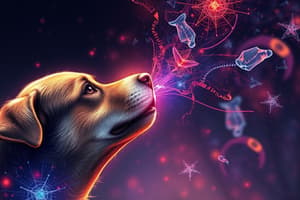Podcast
Questions and Answers
What does the visual processing circuit involving the primary visual cortex primarily enable?
What does the visual processing circuit involving the primary visual cortex primarily enable?
- Discerning depth using binocular cues
- Understanding complex visual scenes
- Recognition of human faces
- Detection of simple features like lines and edges (correct)
Which law suggests that objects that are close to one another are perceived as a group?
Which law suggests that objects that are close to one another are perceived as a group?
- Proximity (correct)
- Continuity
- Law of Closure
- Law of Similarity
What is the term for the condition where an individual has difficulty recognizing faces?
What is the term for the condition where an individual has difficulty recognizing faces?
- Hemi neglect
- Prosopagnosia (correct)
- Color blindness
- Visual agnosia
Which type of cues are monocular cues based on?
Which type of cues are monocular cues based on?
Hemi neglect is characterized by what specific behavior?
Hemi neglect is characterized by what specific behavior?
What role does the unconditioned stimulus play in classical conditioning?
What role does the unconditioned stimulus play in classical conditioning?
Which statement accurately describes a neutral stimulus in classical conditioning?
Which statement accurately describes a neutral stimulus in classical conditioning?
What happens during the acquisition phase of classical conditioning?
What happens during the acquisition phase of classical conditioning?
Which statement correctly describes a conditioned response?
Which statement correctly describes a conditioned response?
How does the number of pairings between the conditioned stimulus and the unconditioned stimulus affect learning?
How does the number of pairings between the conditioned stimulus and the unconditioned stimulus affect learning?
What is the unconditioned response (UR) in the context of taste aversion?
What is the unconditioned response (UR) in the context of taste aversion?
What effect does the amygdala have on phobic individuals when they encounter a feared object?
What effect does the amygdala have on phobic individuals when they encounter a feared object?
In John Garcia's studies, what was the primary method used to create conditioned taste aversions in rats?
In John Garcia's studies, what was the primary method used to create conditioned taste aversions in rats?
Why do organisms tend to form taste aversions specific to the food consumed rather than other stimuli?
Why do organisms tend to form taste aversions specific to the food consumed rather than other stimuli?
What distinguishes operant conditioning from classical conditioning?
What distinguishes operant conditioning from classical conditioning?
What was Thorndike's contribution to the understanding of operant conditioning?
What was Thorndike's contribution to the understanding of operant conditioning?
What is a key principle of behaviorism in relation to operant conditioning?
What is a key principle of behaviorism in relation to operant conditioning?
Which of the following is an example of positive reinforcement in operant conditioning?
Which of the following is an example of positive reinforcement in operant conditioning?
What is the term used to describe the return to instinctive behavior that prevents the production of a conditioned response?
What is the term used to describe the return to instinctive behavior that prevents the production of a conditioned response?
What is learned helplessness?
What is learned helplessness?
How can shaping be utilized in behavior modification?
How can shaping be utilized in behavior modification?
Which experiment by Albert Bandura demonstrated the concept of observational learning?
Which experiment by Albert Bandura demonstrated the concept of observational learning?
What role do mirror neurons play in observational learning?
What role do mirror neurons play in observational learning?
What role does the piriform cortex play in the recognition of smells?
What role does the piriform cortex play in the recognition of smells?
Which part of the brain is associated with processing emotions related to smell?
Which part of the brain is associated with processing emotions related to smell?
At what age do children typically start to prefer sour tastes?
At what age do children typically start to prefer sour tastes?
What factor influences the strong taste perception in children?
What factor influences the strong taste perception in children?
What triggers a disgust response in the insula cortex?
What triggers a disgust response in the insula cortex?
How do newborns react to sweet and bitter tastes?
How do newborns react to sweet and bitter tastes?
Which brain area does the thalamus relay signals to for taste processing?
Which brain area does the thalamus relay signals to for taste processing?
What can affect smell sensitivity among individuals?
What can affect smell sensitivity among individuals?
Flashcards are hidden until you start studying
Study Notes
Smell Recognition
- The piriform cortex processes smell information and can adapt based on experiences.
- Conditioning can help people distinguish similar smells, for example, by pairing a smell with a shock.
- The olfactory bulb connects to the amygdala (emotions) and hippocampus (memory), making smell a powerful trigger for memories.
Taste Processing
- Taste receptor cells on the tongue send signals to the thalamus and then to the cerebral cortex.
- The thalamus acts as a relay center for most senses, except smell.
- Pleasant tastes activate similar brain areas, while unpleasant tastes activate different areas.
Taste and Smell Integration
- Taste and smell are processed separately but converge in the prefrontal cortex.
- The insula cortex processes taste and is associated with feelings of disgust.
Development of Smell and Taste
- Newborns can recognize their mother's scent within hours of birth and show a preference for her amniotic fluid odor even before birth.
- Babies quickly learn the smell of their mother's milk, which calms them.
- Newborns have a well-developed sense of taste and prefer sweet tastes.
Changing Taste Preferences
- Children start to prefer sour tastes around age 7.
- Bitter taste aversion typically lasts until young adulthood.
- Taste buds develop before birth, and newborns have more than adults.
- Children have taste buds in more areas than adults, which might contribute to picky eating.
Individual Differences in Smell and Taste
- Sensitivity to smells varies widely among individuals.
The Brain and Sight
- Basic visual information is transmitted through the brain via partially crossed axons.
- Visual information from the middle of your visual field is sent to the other side of your brain.
- The primary visual cortex processes simple features like lines and edges.
- Complex visual stimuli processing involves association areas of the visual cortex.
Prosopagnosia
- Prosopagnosia is the inability to recognize faces, even familiar ones.
Hemi Neglect
- Hemi neglect involves ignoring one side of the visual field.
Visual Perceptual Organization
- Figure-ground perception helps identify the main object in a visual field.
- Proximity suggests that stimuli near one another are grouped together.
- Continuity suggests that we tend to fill in gaps to perceive whole objects.
- Similarity indicates that stimuli resembling each other are grouped together.
Binocular and Monocular Cues
- Binocular cues use both eyes to perceive depth.
- Monocular cues use one eye to perceive depth.
- Retinal disparity, the difference in the stimuli recorded by each eye, is a binocular cue of depth.
Classical Conditioning
- Classical conditioning involves associating two previously unrelated stimuli.
- Unconditioned Stimulus (US) naturally triggers a response (e.g., food).
- Unconditioned Response (UR) is the natural, unlearned response to the US (e.g., salivation).
- Neutral Stimulus (NS) initially elicits no response but becomes associated with the US after repeated pairings.
- Conditioned Stimulus (CS) is the formerly neutral stimulus that elicits a response after pairing with the US (e.g., a bell).
- Conditioned Response (CR) is the learned response to the CS, similar to the UR (e.g., salivation to the bell).
Processes of Classical Conditioning
- Acquisition of the association between the CS and US is a key process in classical conditioning.
- The more CS-US pairings, the stronger the learning.
- Classical conditioning can occur quickly.
Phobias and the Brain
- Phobias are intense fears triggered by specific objects or situations.
- The amygdala, responsible for processing emotions, shows increased activity in phobic individuals when exposed to feared objects.
Taste Aversion
- John Garcia demonstrated that taste aversions can be conditioned in animals.
- Garcia effect: Rapid learning of taste aversion.
- Taste aversions are specific and form quickly.
Conditioned Aversions and Visual Cues
- Animals can learn to associate visual cues with harmful substances, like aposematic coloring in butterflies.
Operant Conditioning
- Operant conditioning involves modifying behavior based on the consequences of actions.
- Behavior that leads to positive outcomes is repeated, while behavior that leads to negative outcomes is avoided.
- Thorndike's puzzle box demonstrated that cats learned to escape the box by pressing a pedal for a fish reward.
How Operant Conditioning Works
- Behaviorists believed that observable behavior should be objectively studied.
- Instinctive drift refers to the return to instinctive behavior, which can interfere with conditioning.
- Shaping involves reinforcing successive approximations of a desired behavior.
Behavior Modification
- Behavior modification uses operant conditioning principles to change behaviors.
- Learned helplessness occurs when repeated exposure to inescapable punishment leads to a failure to escape.
Observational Learning and Aggression
- Albert Bandura showed that children learn aggression by observing behavior.
- Vicarious learning: Learning by observing the consequences of others' actions.
- Mirror neurons fire both when we perform an action and when we see others perform it.
Studying That Suits You
Use AI to generate personalized quizzes and flashcards to suit your learning preferences.




